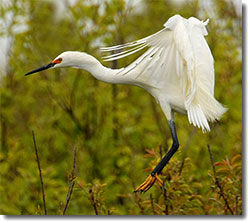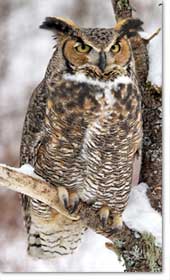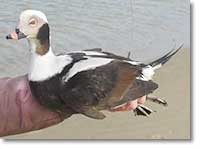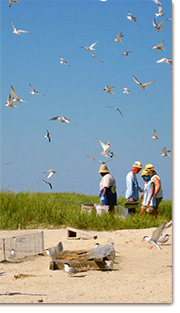| |
MassAudubon.org | Tell a friend | Become a Member | Donate
February 2009
Welcome to the inaugural issue of The Warbler, Mass Audubon’s e-newsletter on birds, birding, and bird conservation! The Massachusetts birding community is large and wide-reaching, and our goal is to work closely with this community to protect birds.
| |

Snowy Egret landing, photo by Craig Gibson
|
With so much going on in the world of birds and at Mass Audubon, The Warbler will let us share news with you about all we do to protect and increase the enjoyment of birds. Perhaps you know about the Long-tailed Duck telemetry project and its relationship to our work on Cape Wind, but you may not have heard we are working on the second Massachusetts Breeding Bird Atlas to document all breeding birds of the Commonwealth.
Why The Warbler—why today? February 10th may not be a major holiday on most calendars, but at Mass Audubon it is a special day. One hundred and thirteen years ago today, our Founding Mothers, Harriet Hemenway and Minna Hall, held a meeting and set out to end the practice of slaughtering birds for use on women’s hats. This gathering long ago launched the Massachusetts Audubon Society and blazed the trail for the conservation, education, and advocacy organization we are today.
We hope you enjoy The Warbler. Please let us know what you think, and tell us what else you’d like to read in future editions.
Happy Birding!
Taber Allison
VP, Conservation Science and Ecological Management
Becky Harris
Director, Coastal Waterbird Program
Chris Leahy
Gerard A. Bertrand Chair of Natural History and Field Ornithology
Simon Perkins
Field Ornithologist
Wayne Petersen
Director, Massachusetts Important Bird Areas
Joan Walsh
Breeding Bird Atlas Coordinator
| |

Great Horned Owl
|
Hear a Hoot?
Our Breeding Bird Atlas 2 project intends to define the breeding range of every species in Massachusetts, but not all birds are easy to find. Owls, for example, are notoriously easy to overlook.
Happily, with our new Owl Reporter mapping tool, we can harness the enthusiasm of any interested owler or casual observer, gather the data online, and share the sightings with our trained Breeding Bird Atlas volunteers to enhance their surveys. Look at how the data illustrates the range of our local breeding birds, such as the Great Horned Owl!
The Owl Reporter has already yielded more than 100 new sightings and helped connect people to our ongoing research projects. Please send us any owl sightings that you have; your input is important! You can also learn more about Massachusetts owls on our website.
|

Long-Tailed Duck, photo by
Matthew Perry, USGS.
|
|
Duck Rodeo, Mass Audubon Style
Long-tailed Ducks are extraordinarily abundant around Nantucket with perhaps a quarter of the North American population there each winter. For two years, we’ve been tracking Long-tailed Ducks in these waters by catching them (see How to Catch a Duck in the sidebar) and implanting small satellite transmitters in the birds.
Our study’s main focus has been to determine the nighttime roosting locations of Long-tailed Ducks within Nantucket Sound and better understand the potential impact of the proposed Cape Wind project. Our data have been contributed to the Cape Wind Environmental Review.
We know roughly how many ducks are there (a minimum of a half a million!) and where they feed (the Nantucket Shoals) because they form a veritable torrent of flying birds during spectacular dawn and dusk commutes between their daytime feeding grounds and their nighttime roosting sites. The potential environmental impact of Cape Wind would cause significant concern if we found that most of the ducks roost within the proposed project area. Remarkably, so far not a single transmitter data point has fallen within that part of the Sound.
The Right Moves
A big part of Mass Audubon’s mission is to protect the birds of Massachusetts. With more than 200 breeding species in the Commonwealth, one big challenge is deciding where to direct our protection efforts. How do we focus?
First we assess bird population conditions through programs like the Breeding Bird Atlas to identify species in trouble and, specifically, identify our species of responsibility—those birds we believe Massachusetts has a particular responsibility to protect. Using the best available science, we attempt to determine factors in the species’ decline, and whether our conservation efforts will make a real difference. After designing and implementing appropriate programs, we continue monitoring the birds to evaluate our success. We refine the interventions and repeat the process.
Our well-known Coastal Waterbird Program shows the power of this approach, having contributed to impressive increases in Piping Plover and tern populations in Massachusetts. Now we are expanding our efforts to other species. Your invaluable contributions to our monitoring efforts through volunteer work and financial support make this all possible. To learn more about how you can help us make the right moves, contact Henrietta Yelle at 781-259-2239 or hyelle@massaudubon.org. |
|
|
|
CALLING ALL BIRDERS!
17th Annual Birders Meeting
March 7, 2009
Seasoned pro or a new backyard birdwatcher? This day is for you! Hear field guide author Kenn Kaufman and Lee Allen Peterson, the son of “America’s greatest naturalist,” plus much more. Registration details >>
OWLS IN THE NEWS
See one local snowy owl get its 15 minutes of fame on WBZ-TV with Mish Michaels and Mass Audubon’s Norm Smith.
THRILLS AND CHILLS
See Boston Globe coverage of the first Cape Ann Birding Weekend!
UPCOMING PROGRAMS
Here’s a sampling of our many bird-related programs you can enjoy statewide.
Owl Programs Statewide:
Feb 14:
Owls By Moonlight
Wachusett Meadow
Feb 18:
Owl Moon
Moose Hill
Feb 21:
Dusk Owl Walk
Burncoat Pond
More owl programs >>
Birding Cape Cod and the Islands:
Feb 14:
Winter Birding
Coast Guard Beach
Eastham
Feb 20:
Birding Cape Cod
Outer Cape
Feb 28:
Discover Upper Cape Cod
Birding
Cape Cod Canal
More Cape & Islands Birding >>
Birding Greater Boston:
Feb 14:
Winter Raptors
Blue Hills
Feb 21:
HIP Morning Bird Walk
Habitat
Feb 21:
Mission Possible
Greater Boston
More Greater Boston Birding >>
Birding the Berkshires:
Feb 21:
Eagles at Quabbin
Quabbin Reservoir
More Berkshires Birding >>
Birding programs for February 2009 >>

HOW TO CATCH A DUCK
Not all ducks are created equal. Scoters and eiders, many of which coexist with the Long-tailed Ducks in the waters around Nantucket, are the seaduck equivalent of an old pickup truck: big and slow.
Long-tails, on the other hand, are the Ferraris of the seaduck world. Who knew? It took us two years of trial and error to figure out how to catch these avian rockets. We tried to out-run them with the fastest boat in town (50 mph!) to get close enough to shoot a net over them. They were much faster.
We tried to outsmart them by sneaking up on them whenever they dove underwater for food. They were much smarter.
Finally, it dawned on us: think poacher! We “froze” them with high-intensity spotlights as they floated on the water at night until we got close enough to scoop them up from the bow with long-handled nets.

Protecting terns with a beach enclosure. |
|
